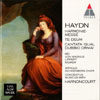Haydn Mass No 14; Te Deum
Nikolaus Harnoncourt presents a typically uncompromising view of Haydn's final Mass, not so much a glowing summation as a work of unease and even violence
View record and artist detailsRecord and Artist Details
Composer or Director: Joseph Haydn
Label: Teldec (Warner Classics)
Magazine Review Date: 2/2000
Media Format: CD or Download
Media Runtime: 65
Mastering:
DDD
Catalogue Number: 3984-21474-2

Tracks:
| Composition | Artist Credit |
|---|---|
| Mass No. 14, 'Harmoniemesse' |
Joseph Haydn, Composer
(Arnold) Schoenberg Choir Concentus Musicus Elisabeth von Magnus, Mezzo soprano Eva Mei, Soprano Herbert Lippert, Tenor Joseph Haydn, Composer Nikolaus Harnoncourt, Conductor Oliver Widmer, Bass |
| Qual dubbio ormai |
Joseph Haydn, Composer
(Arnold) Schoenberg Choir Concentus Musicus Eva Mei, Soprano Joseph Haydn, Composer Nikolaus Harnoncourt, Conductor |
| Te Deum for Prince Nicolaus Esterházy |
Joseph Haydn, Composer
(Arnold) Schoenberg Choir Concentus Musicus Elisabeth von Magnus, Mezzo soprano Eva Mei, Soprano Herbert Lippert, Tenor Joseph Haydn, Composer Nikolaus Harnoncourt, Conductor Oliver Widmer, Bass |
Author: Richard Wigmore
If you think of Haydn's final Mass as a glowing, even valedictory work, then think again. For Harnoncourt, it seems, the Harmoniemesse is no less a Mass in time of war than the Paukenmesse or the Nelson Mass. Even in the Kyrie, one of Haydn's noblest slow movements, he generates an underlying unease, with extreme dynamic contrasts, stabbing accents and a turbulent final climax where, characteristically, he urges the tempo forward before making a massive rallentando in the closing bars. The opening section of the Gloria is aggressively martial, the 'Qui tollis' violent in its intensity, with jabbing staccatos from the choir and minatory trumpets piercing through the texture. There is more slashing staccato violence in the 'Crucifixus', while the 'Pleni sunt coeli', taken at a furious tempo, here sounds desperate rather than joyfully affirmative; and, more than in any performance I have heard, Harnoncourt stresses the undercurrent of fear and disquiet in the 'Benedictus'. At every possible point in the Mass, in fact, he emphasises the music's disruptive, destabilising elements - the dissonant woodwind trills at 'Et exspecto resurrectionem mortuorum' (2'27') are one example among many. But the romantic lurking within the agent provocateur reveals himself in the free - and sometimes plain wayward - approach to tempo, nowhere more so than in the final section of the Credo. And, typically, the wonderfully inspiriting fugues that close the Gloria and Credo here begin almost daintily, with mannered-sounding phrasing and articulation.
Harnoncourt is, as ever, faithfully served by his orchestra (pungent - if not always perfectly tuned - woodwind and brass characteristically to the fore) and his accomplished, ultra-responsive choir, which suffers slightly in the recorded balance. The star among the soloists is Eva Mei, who brings a touching tenderness and a shapely sense of phrase to the 'Et incarnatus est'; on the downside, though, Elisabeth von Magnus's quavery, uneven singing makes for uncomfortable listening in the 'Gratias'. On the rival Chandos version Richard Hickox's mezzo, Pamela Helen Stephen, is far preferable. Indeed, unless you're addicted to Harnoncourt's extremist, at times subversive, approach to this repertoire - and I don't deny that there are powerful and disturbing insights here - Hickox's is undoubtedly the version to go for: hardly less dramatic, but more naturally shaped and paced and distilling a serenity and joyous fervour which Harnoncourt consistently seeks to eschew.
The two shorter items, both dating from the early 1760s, are unlikely to affect the choice of most readers, though serious Haydn collectors will want the rare celebratory cantata Qual dubbio ormai with its central coloratura showpiece, here brilliantly negotiated by Eva Mei.'
Harnoncourt is, as ever, faithfully served by his orchestra (pungent - if not always perfectly tuned - woodwind and brass characteristically to the fore) and his accomplished, ultra-responsive choir, which suffers slightly in the recorded balance. The star among the soloists is Eva Mei, who brings a touching tenderness and a shapely sense of phrase to the 'Et incarnatus est'; on the downside, though, Elisabeth von Magnus's quavery, uneven singing makes for uncomfortable listening in the 'Gratias'. On the rival Chandos version Richard Hickox's mezzo, Pamela Helen Stephen, is far preferable. Indeed, unless you're addicted to Harnoncourt's extremist, at times subversive, approach to this repertoire - and I don't deny that there are powerful and disturbing insights here - Hickox's is undoubtedly the version to go for: hardly less dramatic, but more naturally shaped and paced and distilling a serenity and joyous fervour which Harnoncourt consistently seeks to eschew.
The two shorter items, both dating from the early 1760s, are unlikely to affect the choice of most readers, though serious Haydn collectors will want the rare celebratory cantata Qual dubbio ormai with its central coloratura showpiece, here brilliantly negotiated by Eva Mei.'
Discover the world's largest classical music catalogue with Presto Music.

Gramophone Digital Club
- Digital Edition
- Digital Archive
- Reviews Database
- Full website access
From £8.75 / month
Subscribe
Gramophone Full Club
- Print Edition
- Digital Edition
- Digital Archive
- Reviews Database
- Full website access
From £11.00 / month
Subscribe
If you are a library, university or other organisation that would be interested in an institutional subscription to Gramophone please click here for further information.




